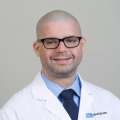When Audrey Lapidus’ 10-month old son, Calvin, didn’t reach normal milestones like rolling over or crawling, she knew something was wrong.
“He was certainly different from our first child,” said Lapidus, of Los Angeles. “He had a lot of gastrointestinal issues and we were taking him to the doctor quite a bit.”
Four specialists saw Calvin and batteries of tests proved inconclusive. Still, Lapidus persisted.
“I was pushing for even more testing, and our geneticist at UCLA said, ‘If you can wait one more month, we’re going to be launching a brand new test called exome sequencing,’” she said. “We were lucky to be in the right place at the right time and get the information we did.”
In 2012, Calvin Lapidus became the first patient to undergo exome sequencing at UCLA. He was subsequently diagnosed with a rare genetic condition known as Pitt-Hopkins syndrome, which is most commonly characterized by developmental delays, possible breathing problems, seizures and gastrointestinal problems.
Though there is no cure for Pitt-Hopkins, finally having a diagnosis allowed Calvin to begin therapy. “The diagnosis gave us a point to move forward from, rather than just existing in that scary no-man’s land where we knew nothing,” Lapidus said.
“Unfortunately, there are a lot of people living in that no-man’s land, desperate for any type of answers to their medical conditions,” said , professor of human genetics and pathology and laboratory medicine at the David Geffen School of Medicine at UCLA. “Many families suffer for years without so much as a name for their condition.”
What exome sequencing allows doctors to do is to analyze more than 20,000 genes at once, with one simple blood test.
In the past, genetic testing was done one gene at a time, which is time-consuming and expensive.
“Rather than testing one sequential gene after another, exome sequencing saves time, money and effort,” said Dr. Julian Martinez-Agosto, a pediatrician and researcher at the Resnick Neuropsychiatric Hospital at UCLA.
The exome consists of all the genome’s “exons,” which are the coding portion of genes. Clinical exome sequencing is a test for identifying disease-causing DNA variants within the 1 percent of the genome which codes for proteins, the exons, or flanks the regions which code for proteins.
To date, mutations in the protein-coding parts of genes accounts for nearly 85 percent of all mutations known to cause genetic diseases, so surveying just this portion of the genome is an efficient and powerful diagnostic tool. Exome sequencing can help detect rare disorders like spinocerebellar ataxia, which progressively diminishes a person’s movements, and suggest the likelihood of more common conditions like autism spectrum disorder and epilepsy.
More than 4,000 adults and children have undergone exome testing at UCLA since 2012. Of difficult to solve cases, more than 30 percent are solved through this process, which is a dramatic improvement over prior technologies. Thus, Nelson and his team support wider use of genome-sequencing techniques and better insurance coverage, which would further benefit patients and resolve diagnostically difficult cases at much younger ages.
Since her son’s diagnosis, Lapidus helped found the Pitt-Hopkins Syndrome Research Foundation. “Having Calvin’s diagnosis gave us a roadmap of where to start, where to go and what’s realistic as far as therapies and treatments,” she said. “None of that would have been possible without that test.”
Next, experts at UCLA are testing the relative merits of broader whole genome sequencing to analyze all 6 billion bases that make up a person’s genome. The team is exploring integration of this DNA sequencing with state-of-the-art RNA or gene expression analysis to improve the diagnostic rate.
The entire human genome was first sequenced in 1990 at a cost of $2.7 billion. Today, doctors can perform the same test at a tiny fraction of that cost, and believe that sequencing whole genomes of individuals could vastly improve disease diagnoses and medical care.






